
| Home | Deepsky Atlas | TheAstronews | Links | Solar System | ||||||

Hawaiian Astronomical SocietyConstellations: Leo -- The Nemaean Lion Killed by Hercules |
||||||||||
The first involved killing the monstrous, man-eating lion of Nemaea (Leo, the Lion). He tried to kill it with his special arrows and his club, but both weapons broke into pieces as if they were made of clay. After using the weapons in vain, he strangled the lion with his bare hands, succeeding his first task.
When he returned to Eurystheus, the king fled in terror at the sight of the monster. He ordered Herakles to enter Mycenae only when bidden. Eurytheus was a cautious man. He had a specially fortified room made to which he could retreat when Herakles proved too frightening. Herakles could indeed look fiercesome; he wore the skin of the lion the rest of his days.
Click here for the next labor.
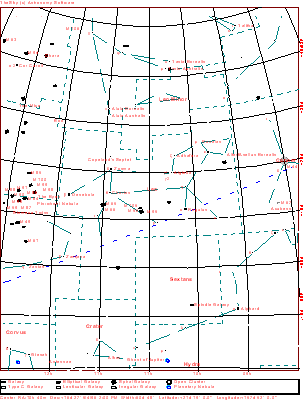
Click the map for a 909x1199 version of the above. Click here for a map better suited for use in the field.
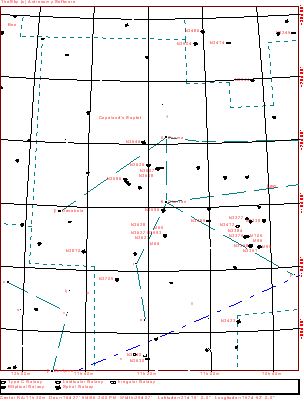
This a more detailed view of the constellation. The map displays stars to magnitude 10, and deepsky objects to magnitude 12. Click here for a map better suited for use in the field.
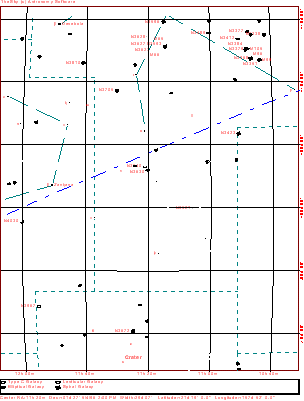
Click here for a map better suited for use in the field.
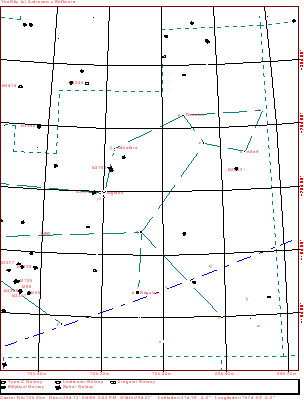
Click here for a map better suited for use in the field.
 54k JPEG Photographer's notes: 45 min. exposure with ST-7 CCD on 4" f/5 Genesis. Stan Moore 54k JPEG Photographer's notes: 45 min. exposure with ST-7 CCD on 4" f/5 Genesis. Stan Moore
We see M65 (NGC3623, mag. 10.1, size 10'x3', top, right), M66 (NGC3627, mag. 9.6, size 9'x4', bottom, right), and NGC3628 (Best 64, mag. 10.5, size 15'x3', left). Located in the hind quarters of Leo, 2.5° SW of Chertan (Theta Leonis). A pretty trio in a 3", an eyepiece with a 1° field will easily show all three. Larger instruments will show structure, particularly in M66.
|
 11k JPEG The fainter galactic companion to M65 and M66 in south-eastern Leo. NGC3628 is mag. 9, and is 10x3.3' in size. Dreyer describes it as pretty bright, large, and very elongated (a P.A. of 102-104°). Galaxy image taken on 1/5/95 with st6 ccd and 8" lx200 -50.02 5 minute grab taken by Tim Puckett. 11k JPEG The fainter galactic companion to M65 and M66 in south-eastern Leo. NGC3628 is mag. 9, and is 10x3.3' in size. Dreyer describes it as pretty bright, large, and very elongated (a P.A. of 102-104°). Galaxy image taken on 1/5/95 with st6 ccd and 8" lx200 -50.02 5 minute grab taken by Tim Puckett.
|
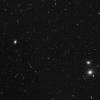 63k JPEG NGC3626 (Caldwell 40, on the photograph's left side) is a bright (mag. 10.9), small (2.8'x2'), slightly elongated spiral galaxy with a pronounced brighter core. It lies 2.6° SE of Zosma (Delta Leonis). Other galaxies in this one degree field include NGC3608 (mag. 11.8, 1.4'x1.0' on the right), and NGC3607 (Best 63, mag. 11, 1.8'x1.3', just below, or south of 3608). The tiny companion to 3607 is NGC3605 (mag. 13.1, 1.4'x0.8'). 63k JPEG NGC3626 (Caldwell 40, on the photograph's left side) is a bright (mag. 10.9), small (2.8'x2'), slightly elongated spiral galaxy with a pronounced brighter core. It lies 2.6° SE of Zosma (Delta Leonis). Other galaxies in this one degree field include NGC3608 (mag. 11.8, 1.4'x1.0' on the right), and NGC3607 (Best 63, mag. 11, 1.8'x1.3', just below, or south of 3608). The tiny companion to 3607 is NGC3605 (mag. 13.1, 1.4'x0.8').
|
NGC3521 shines at mag. 9.8. Its size is 10.9'x5.1', and it is located in south-eastern Leo, 4.5° north-west of Phi Leonis. Image on the left is from Taku's CCD Gallery. Image on the right is a drawing by Jere Kahanpää.
|
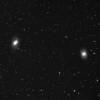 81k JPEG M95 (NGC 3351) is a bright (mag. 10.7), large (8.5'x5'), barred spiral galaxy located 3.6° NE of Rho Leonis, just south of the center of Leo's body. Dreyer also describes a gradual brightening toward the core. M96 (NGC3368) is slightly brighter (mag. 9.9) large (7.5'x5') spiral galaxy 42' to the left (east). Brightening to the core is more pronounced than with M95. From the Digital Sky Survey. 81k JPEG M95 (NGC 3351) is a bright (mag. 10.7), large (8.5'x5'), barred spiral galaxy located 3.6° NE of Rho Leonis, just south of the center of Leo's body. Dreyer also describes a gradual brightening toward the core. M96 (NGC3368) is slightly brighter (mag. 9.9) large (7.5'x5') spiral galaxy 42' to the left (east). Brightening to the core is more pronounced than with M95. From the Digital Sky Survey.
|
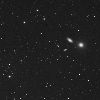 88k JPEG M105 (NGC3379) sits just .8° NNE of M96. At mag. 10.1, this elliptical galaxy is slightly dimmer overall than its partner, but its smaller size (4'x4') makes it easier to see. Dreyer reports it is also quite condensed in the center. From the Digital Sky Survey. This image contains a host of other galaxies. Here are some of the brightest: NGC3384 (Best 61, mag. 10.7, 1.6'x1.1') lies .3' ENE. NGC3389 (mag. 12.4, 2.6'x1.2') lies 10' ESE and forms a nice trio in moderate sized scopes. Many other galaxies to mag. 16 inhabit this image. 88k JPEG M105 (NGC3379) sits just .8° NNE of M96. At mag. 10.1, this elliptical galaxy is slightly dimmer overall than its partner, but its smaller size (4'x4') makes it easier to see. Dreyer reports it is also quite condensed in the center. From the Digital Sky Survey. This image contains a host of other galaxies. Here are some of the brightest: NGC3384 (Best 61, mag. 10.7, 1.6'x1.1') lies .3' ENE. NGC3389 (mag. 12.4, 2.6'x1.2') lies 10' ESE and forms a nice trio in moderate sized scopes. Many other galaxies to mag. 16 inhabit this image.
|
NGC2916 is located about 40' ENE of NGC2903. It shines at mag. 12.4 and measures 2.5'x1.6'.
The image to the left is from the Digital Sky Survey. The image to the right is from the Vatican Advanced Technology Telescope.
|
If you have any questions about the Hawaiian Astronomical Society
please
(link requires javascript).